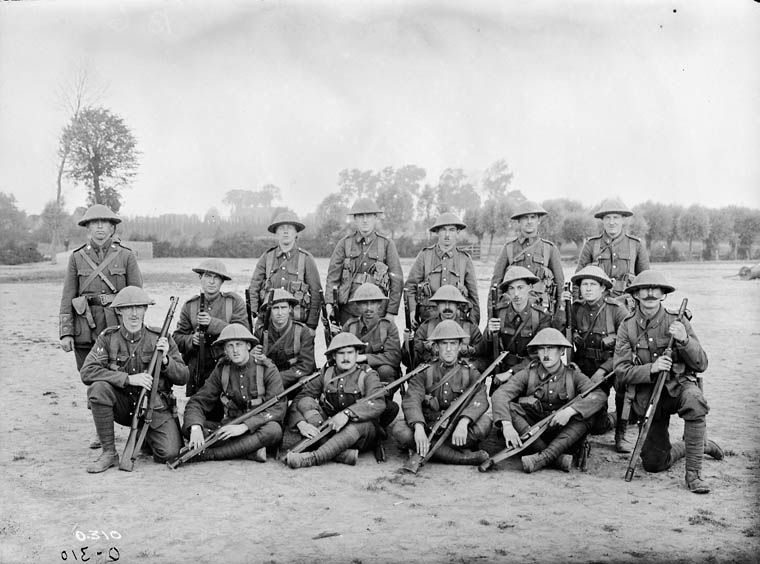Signaller Guy Wray Garrett 678042 was born 5 November 1894 in Toronto. He resided at 264 Clifton Street, Toronto. Guy was a Hardware merchant, working for his father. Parents George and Alice Garrett resided at 582 College Street, Toronto. During his training in England, he will marry Ethel, of 63 Knatts Green Road, Leyton East, London, England. Later, they will have a child. But unfortunately, Guy will never hold their baby in his arms.

Service
Guy began his service by attesting on 27 January 1916, with 169th Battalion in Toronto. Guy stood 5’8″ tall, 149 pounds, with fresh complexion, brown eyes and hair. First, Guy Wray Garrett is promoted Corporal, at Bramshott Camp, 28 June 1916. While training in Bramshott, Guy meets his future wife, Ethel. Then, their marriage is approved by the OC, on 30 April 1917. And then, to duty as Brigade Signalling Sergeant, 30 May 1917. Also on the same day, to be A/Company Sergeant Major.

Reverts to ranks
After his rise in the ranks, it is nothing but downgrades until Guy makes it overseas. Firstly, reverts to Acting Sergeant 24 November 1917. Secondly, reverts to rank of A/Corporal 27 November 1917. Then, he makes a tragic decision. Though Ethel is pregnant, finally, he reverts to Private at own request, in order to proceed overseas, 16 February 1918.
Overseas
First, Guy proceeds overseas as a Signaller with the 1st Canadian Mounted Rifles (Saskatchewan Regiment), 16 February 1918. Then, he catches up with his unit at Camblain l’Abbé on 20 February, with 14 Other Ranks.

Then, he immediately proceeds by train to ZIVY SIDING, Neuville Saint Vaast (the Canadian Mounted Rifles are a dismounted unit). Finally, on 24 February 1918, the 1st Bn. C.M.R. relieve the 4th Bn. C.M.R. in the Front Line. Guy’s first tour in the trenches is a long one. However, only Corporal Maurice Ashe fell, on the first day of the tour. Still, it is fairly quiet. Finally, the tour ends on 2 March 1918.

In March 1918, a total of six men in the 1st C.M.R. are killed-in-action. Later, all bodies are recovered. The 1st C.M.R. are in Brigade Support, at Hanson Camp, Neuville St. Vaast, for the first two weeks of April 1918. Then, they return to the Front Line at Hill 70, on 13 April 1918. Finally, after five days in the trenches, they are pulled back into Brigade Support, returning to the trenches again on 25 April.
All Quiet on the Western Front
Once again, there is not a lot of activity in the sector. It is quiet here, unlike the rest of the Western Front. The Final German Spring Offensive is in full gear. But, the German Army knows where the Canadians are. This is the reason it is all quiet – only in this area of the Western Front.
In April 1918, a total of seven deaths for the 1st C.M.R., and all remains recovered. Four deaths in May, and again, all recovered. Only one casualty in June. Most of the month is spent training, and preparing for the Sports Competition on Dominion Day. In July, only four men, including POW Private John Howard Crowe, die. Private Crowe died in Westphalia, and lies buried in Cologne Southern Cemetery.
Early Spring of 1918, while Guy is on the Western Front, Ethel gives birth. Guy suggests she travel to Canada and live with his parents in Toronto. Ethel agrees, and she arrives in the Summer of 1918.
Battle of Cambrai
In August 1918, the 1st C.M.R. go on the offensive in the Battle of Amiens, and later in the month, the Battle of the Scarpe. Seventy-six men of the 1st C.M.R. are killed-in-action. The remains of nine of these soldiers are lost, or never found. There names are therefore found on the Vimy Memorial.
Then, it gets worse for the 1st C.M.R., in September 1918. One-hundred-eighteen men are killed, fifteen of these men are named on Vimy. Finally, casualties are now approaching a breaking-point for the 1st C.M.R. However, the unit has lost too many of it’s battle-seasoned veterans. Now, with too many green recruits, the unit sees limited action in October 1918. And even less in the final week of the war, when only one man is killed-in-action. However, on 9 October 1918, the second day of the Battle of Cambrai, Guy is hit by fragments from a high-velocity shell, and is the eleventh-to-last man to be killed in action in the 1st C.M.R.
Death
During operations with his Battalion on the Arras-Cambrai road, he was rendered unconscious by the explosion of a high velocity enemy shell. While being conveyed to No.9 Canadian Field Ambulance, his wounds were dressed twice. But, he died there, without regaining consciousness. Guy Wray Garrett dies of wounds, No.9 Canadian Field Ambulance, on 9 October 1918. GSW head skull fracture. Guy, passed away, having never felt any pain. His final resting place, Queant Communal Cemetery British Extension, in Pas-de-Calais.
Queant Communal Cemetery British Extension
In addition to Signaller Guy Wray Garrett, Queant Communal Cemetery British Extension includes the remains of two famous men of the Canadian Corps. Firstly, Major-General Louis Lipsett, the commander of the 3rd Canadian Division. Only five days after Signaller Garrett, Lipsett was buried here with full military honours, by the men of his former battalion. Secondly, Samuel Lewis Honey, VC, DCM, MM, was also buried here, only ten days before Guy. Finally, Guy’s sergeant, Harry James Proven was interred here the day before Samuel Honey. Harry lies in the row immediately before Guy.

Epilogue

News of Guys’ death did not take long to reach home.
More
Please subscribe to CEFRG to be notified by email when there are new posts. Subscription is free, and your email kept confidential.
